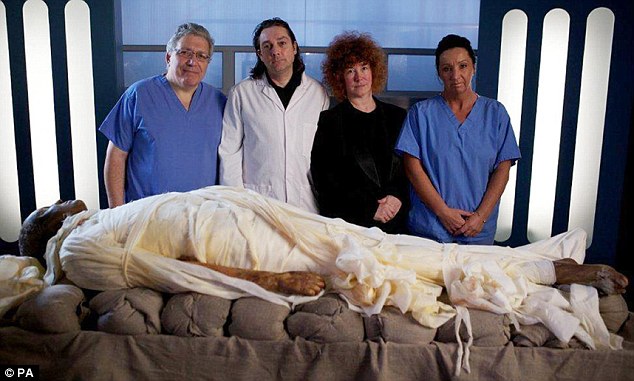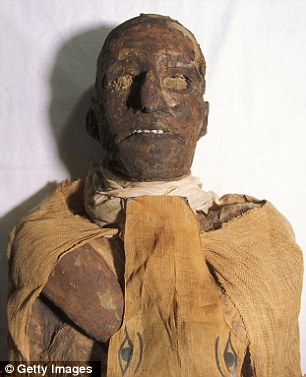The First Man Mummified Like King Tut in 3,000 Years was Terminally Ill Taxi Driver from England
/The late Mr. Billis became the first man mummified in the style of the ancient Egyptians for at least 3,000 years.
Mr. Alan Billis was a taxi driver in Torquay, England who loved documentaries and history. One day saw an ad seeking people willing to be embalmed in the same way as ancient Egypt's King Tutankhamen and, as he was dying from lung cancer, signed up. When he did die at age 61 from the cancer, scientists used the ancient Egyptian embalming techniques not used since 1,323 BC on King Tut's body.
Mr. Billis' wife Janet and their three grown-up children all gave this their blessing. She said "He just said, 'I’ve just phoned someone up about being mummified.' "I said, 'You’ve what?' I thought here we go again. It’s just the sort of thing you would expect him to do."
Torquay's Tutankhamun
English Channel 4's program called "Mummifying Alan: Egypt's Last Secret" recently aired on TV dubbing Alan "Torquay’s Tutankhamun." In the documentary he says,
"People have been leaving their bodies to science for years, and if people don’t volunteer for anything nothing gets found out."
The experts: Professor Vanezis, Dr. Buckley, Dr. Fletcher and Maxine Coe with a mummified Alan Billis before them
Except for Mr. Billis' heart and brain, all his internal organs were taken out and put in jars over several months. To preserve his skin, scientists soaked the body in a mix of oils, Natron salt, and resins for a month in a glass tank in the Medico-Legal Center in Sheffield. Afterwards, they put it into a drying chamber and wrapped it in linen fabric.
According to Dr. Stephen Buckley from the University of York that researched Egyptian mummification techniques, believes Mr. Ballis' body will last for thousands of years.
Dr. Stephen Buckley with mummified Mr. Billis
It's good to note how Mrs. Ballis' feels about all this during and after the process. She told the Radio Times,
“I didn’t find it upsetting. There wasn’t anything scary. I think it was because you could see they all took such good care of Alan.
When I did eventually watch the film and saw his mummified face, you could see it was still him, still very much Alan.
’I won’t be Tutankhamun, I’ll be Tutanalan,’ he used to say. The involvement in the television programme kept him occupied, took his mind off the illness.”
Original Mummies
If you want to check out a real Egyptian mummy, you can see King Rameses III in Egypt's Cairo Museum. As for "Tutan-Alan," he will be being studied by scientists researching decomposition.
The forensic pathologist overseeing the project, Professor Peter Vanezis was impressed with the results saying,
"The skin itself has this leathery appearance which indicates that he has become mummified all over. It makes me very confident that his tissues have been mummified correctly and in a very successful manner."
So are you now considering volunteering your body for scientific research? Do you think ancient Egyptians mummified their bodies so future generations could clone them to resurrect their royal bloodline?
Controversial Plastination Exhibits
Besides mummifying via embalming, there's another technique called plastination. This requires fresh bodies whose fluids have not congealed too much because a plasticine solvent replaces the blood and other bodily fluids. When this hardens, the tissues basically become plastic.
There has been a lot of controversy surrounding a Chinese-based plastination company who cannot prove it got their bodies from willing volunteers nor from bodies left "unclaimed." This company has been parading hundreds of the "unknown" Chinese corpses on display around the world in the Body Exhibitions fully nude with some even engaging in sex acts (which we will not show here). Needless to say, this has sparked shock, outrage, and protests.
According to traditional Chinese culture, the remains of the deceased are treated with great respect and honor. Many Chinese are simply repulsed by such a concept of publicly displaying naked dead bodies. This exhibition is doing something quite different than ancient Egypt preserving their royalty's bodies wrapped up and contained in intricately decorated sarcophaguses. It's even different than privately studying the bodies for medical research, which are also required to be donated.
“A New York Times report found that “Here in China, determining who is in the body business and where the bodies come from is not easy. Museums that hold body exhibitions in China say they have suddenly ‘forgotten’ who supplied their bodies, police officials have regularly changed their stories about what they have done with bodies, and even universities have confirmed and then denied the existence of body preservation operations on their campuses.
In May 2008, a settlement with the attorney general of New York obliged Premier Exhibitions, Sui’s exhibition partner, to publish a disclaimer on its website and at the exhibition hall, stating that the origin of Dalian Hoffen’s cadavers was from ‘the Chinese Bureau of Police.’”
This means these bodies are likely from innocent prisoners of conscience who are victims of a brutal and immoral communist regime.
The largest population of such prisoners in China are of Falun Gong practitioners, who believe in living by the universal principles of Truthfulness, Compassion, and Forbearance and practice a set of qigong-like slow-moving exercises. They have no political aspirations, are non-violent, have no membership system, and don't charge anything.
This kind of traditional self-cultivation practice was well-known and common in Chinese traditional culture. Think of Taoists practicing martial arts and meditation up in the mountains, Buddhist monks farming, training, meditating, and studying Buddhist sutras in temples. It was made available to the public in 1992 by Shifu Li Hongzhi in China and spread by word of mouth to millions of people because of health benefits and being completely free.
However, despite great benefits to society and public popularity, the communist regime could not make money off of it and feared people would become harder to control under its atheistic communist ideology. So, in 1999 the communist dictator Jiang Zemin launched a brutal and unconstitutional persecution campaign arresting, torturing, raping, murdering, and even harvesting organs of Falun Gong practitioners and others.
Sources:
http://fofg.org/2015/03/08/the-dark-secret-of-the-bodies-exhibitions/
https://www.theepochtimes.com/hundreds-protest-bodies-revealed-exhibit-of-plastinated-corpses-in-niagara_1325194.html
http://www.stoporganharvesting.org/

































